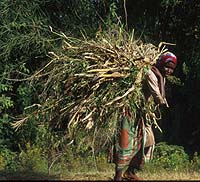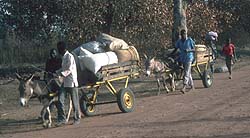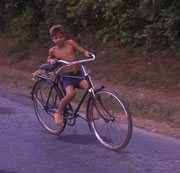|
|
Particularly
poor access to transport for women and children
|
| Women are the main transporters but men are the main users of intermediate
means of transport. Gender-related constraints often limit women's
access to local transport solutions for trade, production and domestic
activities. |

Woman, without access to a
cart, carrying forage in Kenya
|

Men
controlling donkey carts transport goods to market in Guinea Bissau
|
|
Most work animals and carts are owned
by men. Gender-related traditions may make it difficult for women
to own work animals. When ownership is difficult, access to transport
may be possible through hiring or borrowing arrangements.
|
Male-orientated designs
can constrain use by women and children. For example, most bicycles
are designed for men. Women and children have problems riding men's
bicycle and in most rural areas it is difficult to obtain affordable
alternatives.
|

Child riding adult bicycle with
crossbar in Cuba |
|

